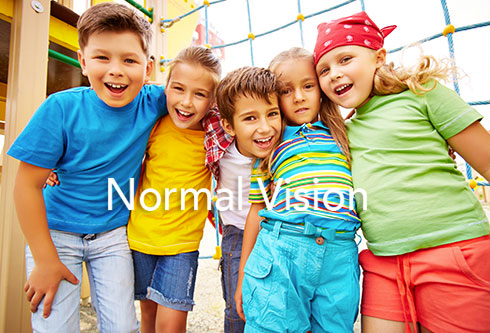8 Facts About Blue Light

Blue Light is Everywhere

Blue Light makes the sky blue

The eye is not very good at blocking blue light

Blue light exposure increases the risk of macular degeneration

Blue light contributes to digital eye strain

Blue light protection may be even more important after cataract surgery

Not all blue light is bad

HPO is dedicated to protecting you from harmful blue light through innovation
What is HEVL?
High Energy Visible Light
In the visible light spectrum, there is a portion of light categorized as high-energy visible light (HEVL). HEVL is blue-violet to blue in color, with wavelengths within the range of 400–500 nm. Often referred to as “blue light”, these waves pass through the lens and reach the retina. Light in the 400–430 nm part of the spectrum is known to be particularly harmful.

What is HEVL Blue Light?
Sunlight contains red, orange, yellow, green and blue light rays and many shades of each of these colors, depending on the energy and wavelength of the individual rays (also called electromagnetic radiation). Combined, this spectrum of colored light rays creates what we call “white light” or sunlight. So how does blue light come into the equation?
There is an inverse relationship between the wavelength of light rays and the amount of energy they contain. Light rays that have relatively long wavelengths contain less energy, and those with short wavelengths have more energy. Light rays on the red end of the visible light spectrum have longer wavelengths and less energy. Light rays on the blue end of the visible light spectrum have short wavelengths and contain more energy and are considerably more damaging to the human body – skin, eyes and even our circadian rhythms which directly affect our wake-sleep cycles.
Sources of HEVL
The largest source of blue light is sunlight.
Additionally, there are many other sources:
The blue light exposure you receive from screens is small compared to the amount of exposure from the sun. Nevertheless, there is concern over long-term effects of screen exposure because of the close proximity of the screens and the length of time spent looking at them. According to a recent NEI-funded* study, children’s eyes absorb more blue light from digital device screens than adults.
When you stare at a screen for hours at a time, whether it is a computer, TV, phone or tablet, you are exposed to blue light from the device. The discomfort some people have after looking at screens is most likely digital eyestrain. Most of us blink less when looking at screens, causing eye strain and dry eye.
Blue light also affects the body’s circadian rhythm, our natural wake and sleep cycle. During the day, blue light wakes us up and stimulates us. But too much blue light exposure late at night from your phone, tablet or computer can make it harder to get to sleep.
* National Eye Institute
Bad Blue Light
Blue Light – The Bad and the Good
Not all blue light is bad. While blue light in the 400-450nm range is harmful, blue light between 450-500nm is considered good blue light and is essential for healthy living. Good blue light boosts alertness, helps memory and cognitive function and elevates mood. It regulates circadian rhythm – the body’s natural wake and sleep cycle. Exposure to blue light during daytime hours helps maintain a healthful circadian rhythm. Too much exposure to blue light late at night (through smart phones, tablets, and computers) can disturb the wake and sleep cycle, leading to problems sleeping, daytime tiredness, and chronic health issues.
The non-visual functions in humans caused by Good Blue light depend on a newly discovered third photoreceptors (ipRGCs)* containing melanopsin, which form a photoreceptive network across the inner retina. Because melanopsin is so important to the daily resetting of our biological clock, its absorption spectrum is also called the chronobiological spectral band. This band is within the blue range with a peak at about 480nm.
* Intrinsic Photo-receptor Retinal Ganglion cell.


Age Related Macular Degeneration (AMD) blinds millions around the globe. In the United States alone AMD accounts for 54% of blindness in individuals 40 years and older. Medical science has demonstrated a link between exposure to visible light primarily in the HEVL (blue/violet) region (within 400-450nm) as a causative factor in human retinal photoreceptor cell death. This cell death (apoptosis) represents one of the earliest phases of AMD. The correlation between HEVL exposure, which comes from sunlight as well as from indoor artificial light, and AMD is now well understood. A growing number of studies and numerous papers support this link. Reducing light in the 400-450 nm range will also lead to improved contrast sensitivity.
Until now, the only known method to block these damaging wavelengths of light was with deep amber or yellow tinted spectacle lenses, blue blocking sunglasses or certain intraocular lenses (IOLs) that are usually implanted later in life after one’s retina may be predisposed for macular degeneration. High Performance Optics’ proprietary technology helps preserve macular integrity by blocking these harmful light rays using a mostly colorless, highly proprietary filter technology. It is important to understand that you are also at risk indoors under artificial light.
HEVL & Age Related Macular Degeneration

The Aging of Our Eyes

Blue Light is Needed for Good Health
Not all blue light is bad. Blue light between 450-500nm is considered good blue light and needed for good health. It boosts alertness, helps memory and cognitive function and elevates mood. It regulates circadian rhythm – the body’s natural wake and sleep cycle. Exposure to blue light during daytime hours helps maintain a healthful circadian rhythm. Too much exposure to blue light late at night (through smart phones, tablets, and computers) can disturb the wake and sleep cycle, leading to problems sleeping and daytime tiredness. Not enough exposure to sunlight in children could affect the growth and development of the eyes and vision. Early studies show a deficiency in blue light exposure could contribute to the recent increase in myopia/nearsightedness.
The non-visual functions in humans, caused by the Good Blue light, depend on a newly discovered third photoreceptor(ipRGCs) containing melanopsin, which form a photoreceptive network across the inner retina. Because melanopsin is so important to the daily resetting of our biological clocks, its absorption spectrum is also called the chronobiological spectral band. This band is within the blue range with a peak at approximately 480 nm
Selective Filtering
The fact that blue light is both beneficial and toxic raises a critical question: Can we protect the eye from harmful blue light without simultaneously denying the physiologically necessary good blue light?
Filtering out ALL blue light is NOT a healthy solution.

Does it harm our skin?
YES
Block the Bad Blue Light While Allowing Good Blue Light to Enter
A better solution is an advanced filtering technology that selectively filters out the harmful wavelengths while transmitting the beneficial ones. This requires advanced research and technology design that will filter out bad blue light while also allowing the important good blue light to pass to our eyes. HPO introduced selective filtering to the world. This is what separates our technology from any other Blue Filtering. In addition, HPO has partnered with advanced chemistry development partners to invent new chemistry that allows for the production of such selective filters which can be integrated to a host of commercial applications that can shield the retina and skin from harmful HEVL while allowing good blue light to pass through the application.



